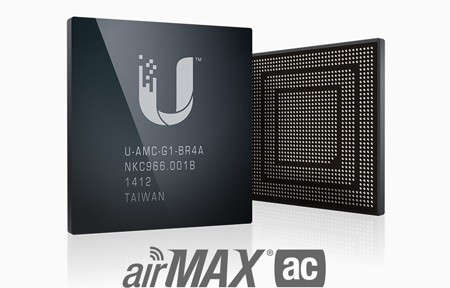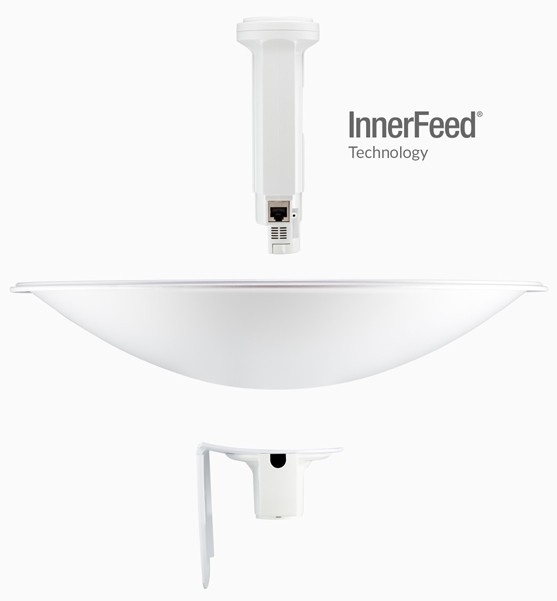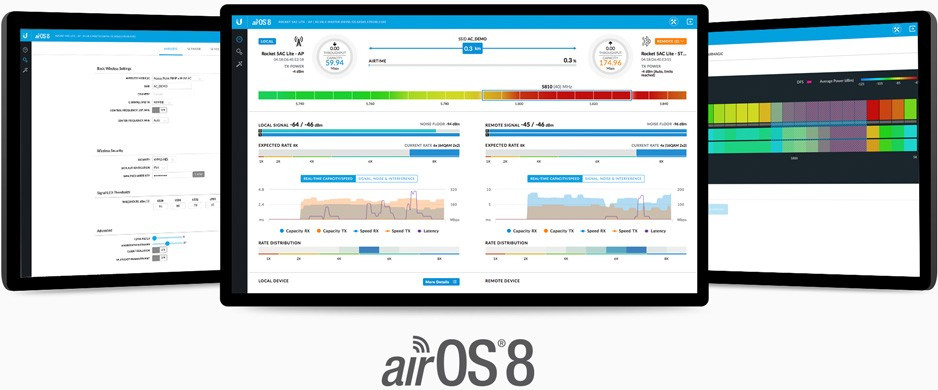2.4 GHz, 18 dBi bridge with 150+ Mbps throughput and 20+ km link range
The airMAX PowerBeam M2 400, designated by the model manufacture part number PBE-M2-400, is a prominent fixture in Ubiquiti Networks' lineup of wireless broadband solutions, specifically engineered for outdoor wireless network applications. Operating in the 2.4 GHz frequency band, this device is crafted to deliver exceptional point-to-point (PtP) and point-to-multipoint (PtMP) connectivity, leveraging Ubiquiti's advanced airMAX technology to provide reliable, high-speed wireless communication over significant distances.
The PowerBeam M2 400 operates within the 2.4 GHz frequency band and uses Ubiquiti's airMAX technology, making it inherently compatible with other airMAX devices that operate on the same frequency. This includes a variety of Ubiquiti's outdoor wireless access points, bridges, and customer premises equipment (CPE), allowing for seamless integration into point-to-point (PtP) and point-to-multipoint (PtMP) networks. Its compatibility is especially valuable in mixed-device environments where various airMAX models coexist to provide comprehensive network coverage. Also, please keep in mind that direct integration with the UniFi series of managed Wi-Fi products is not inherent. The UniFi series operates on a different management platform and serves different networking needs, focusing on managed indoor Wi-Fi applications.
Central to the PowerBeam M2 400's design is its integrated 18 dBi high-gain dish antenna, which boasts a diameter of 400 mm. This antenna within its form factor features the highest gain for its size and is meticulously engineered to focus the radio signal into a tight beam, significantly enhancing the device's ability to transmit and receive data over long distances with minimal interference. The focused beam pattern is crucial for establishing robust wireless links in environments where clear line-of-sight may be obstructed or where ambient RF noise is prevalent.

Ubiquiti's proprietary airMAX technology underpins the PowerBeam M2 400's operation, incorporating a Time Division Multiple Access (TDMA) protocol that optimizes the allocation of communication time slots between network nodes. This innovation dramatically reduces latency, increases throughput, and allows for more efficient utilization of the available bandwidth. Moreover, airMAX technology includes intelligent QoS features, prioritizing traffic to ensure critical data packets, such as those for voice and video applications, are transmitted with minimal delay, thus maintaining high-quality service across the network.

The device is housed in a rugged, weather-resistant enclosure designed to withstand the challenges of outdoor deployment. This durability ensures the PowerBeam M2 400 can operate reliably in a wide array of environmental conditions, from extreme heat to freezing temperatures, and resist the corrosive effects of moisture and wind-driven particulates. The inclusion of a protective radome further shields the antenna from the elements, preserving signal integrity and extending the equipment's lifespan. Also, Ubiquiti’s InnerFeed® technology integrates the radio into the feedhorn of an antenna, so there is no need for cables to connect the radio to the antenna. This improves performance because it eliminates cable losses.
Ease of installation and alignment is a hallmark of the PowerBeam M2 400's design. The device features a robust mounting bracket that facilitates precise orientation and secure attachment to poles or masts. This mounting solution is engineered to enable easy adjustments, ensuring optimal alignment for maximum signal strength and link stability. Such thoughtful design considerations underscore Ubiquiti's commitment to providing solutions that are not only high-performing but also user-friendly and accessible to a broad range of users. The PowerBeam™ requires no tools for assembly; only a single wrench is required for pole-mounting.
Security features within the PowerBeam M2 400 are robust, incorporating advanced encryption standards and access controls to protect the wireless network from unauthorized access and threats. These security measures are critical for maintaining the confidentiality and integrity of data transmitted over the network, ensuring that sensitive information remains secure.
Management of the PowerBeam M2 400 is streamlined through Ubiquiti's airOS interface, a comprehensive and intuitive web-based platform that offers a wealth of features for configuring, monitoring, and optimizing the device. airOS provides network administrators with real-time insights into network performance, including signal strength, noise levels, and throughput statistics, enabling proactive management and troubleshooting of the wireless infrastructure.
Choosing the right PowerBeam
Selecting the right PowerBeam product from Ubiquiti for your network involves a nuanced understanding of your specific needs and environmental conditions. Consider the frequency band: 2.4 GHz models like the PBE-2AC-400 and PBE-M2-400 are adept at penetrating obstacles and are suitable for medium-range deployments, while 5 GHz models, including PBE-5AC-Gen2, PBE-5AC-500, PBE-5AC-620, and PBE-5AC-ISO-Gen2, offer higher throughput and are ideal for clearer, longer-range links. The choice between these depends on the balance between range, throughput, and environmental factors such as different urban / natural obstacles and interference.
Antenna size directly influences range and signal focus: larger dishes on the PBE-5AC-500 and PBE-5AC-620 support the longest distances, whereas the PBE-5AC-Gen2 provides versatile deployment options. The PBE-5AC-ISO-Gen2's enhanced noise isolation makes it perfect for high-interference environments. Lastly, deployment scenarios—whether seeking broad coverage for multiple locations or a focused beam for direct point-to-point links—will guide your selection. Budget considerations and future scalability also play crucial roles in determining the most cost-effective and performance-optimized choice for your wireless network infrastructure.
Compare with similar products
| | | | |
|---|
| Wireless Standard | |
| |
| 802.11a/n
| 802.11a/n
| 802.11a/n
|
| 2.4GHz Radio Rate | |
| |
| 150 Mbps
|
|
|
| 5GHz Radio Rate | |
| |
| 300 Mbps
| 300 Mbps
|
| Wireless Antenna Frequency Range & Gain | |
| |
| 2.405 - 2.475 (GHz) 18 (dBi)
| 5.150 - 5.875 (GHz) 25 (dBi)
| 5.150 - 5.875 (GHz) 25 (dBi)
|
| Antenna range | |
| |
| 20 km
| 25 km
| 25 km
|
| Ethernet Ports | |
| |
| 1 x 100 Mbps
| 1 x 1 Gbps
| 1 x 1 Gbps
|
| Chipset | |
| |
| Atheros MIPS 74Kc, 560 MHz
| Atheros MIPS 74Kc, 560 MHz
| Atheros MIPS 74Kc, 560 MHz
|
| RAM | |
| |
| 64 MB
| 64 MB
| 64 MB
|
| Storage Memory | |
| |
| 8 MB
| 8 MB
| 8 MB
|
| Max Power Consumption | |
| |
| 6 W
| 8 W
| 8 W
|
| Weight | |
| |
| 1.8 kg
| 1.75 kg
| 3.22 kg
|
| | | | |
|---|
| Wireless Standard | 802.11a/n
| 802.11a/n
| 802.11a/n
|
| 2.4GHz Radio Rate | 150 Mbps
|
|
|
| 5GHz Radio Rate |
| 300 Mbps
| 300 Mbps
|
| Wireless Antenna Frequency Range & Gain | 2.405 - 2.475 (GHz) 18 (dBi)
| 5.150 - 5.875 (GHz) 25 (dBi)
| 5.150 - 5.875 (GHz) 25 (dBi)
|
| Antenna range | 20 km
| 25 km
| 25 km
|
| Ethernet Ports | 1 x 100 Mbps
| 1 x 1 Gbps
| 1 x 1 Gbps
|
| Chipset | Atheros MIPS 74Kc, 560 MHz
| Atheros MIPS 74Kc, 560 MHz
| Atheros MIPS 74Kc, 560 MHz
|
| RAM | 64 MB
| 64 MB
| 64 MB
|
| Storage Memory | 8 MB
| 8 MB
| 8 MB
|
| Max Power Consumption | 6 W
| 8 W
| 8 W
|
| Weight | 1.8 kg
| 1.75 kg
| 3.22 kg
|
Technical Specs / Datasheet

 Ubiquiti's proprietary airMAX technology underpins the PowerBeam M2 400's operation, incorporating a Time Division Multiple Access (TDMA) protocol that optimizes the allocation of communication time slots between network nodes. This innovation dramatically reduces latency, increases throughput, and allows for more efficient utilization of the available bandwidth. Moreover, airMAX technology includes intelligent QoS features, prioritizing traffic to ensure critical data packets, such as those for voice and video applications, are transmitted with minimal delay, thus maintaining high-quality service across the network.
Ubiquiti's proprietary airMAX technology underpins the PowerBeam M2 400's operation, incorporating a Time Division Multiple Access (TDMA) protocol that optimizes the allocation of communication time slots between network nodes. This innovation dramatically reduces latency, increases throughput, and allows for more efficient utilization of the available bandwidth. Moreover, airMAX technology includes intelligent QoS features, prioritizing traffic to ensure critical data packets, such as those for voice and video applications, are transmitted with minimal delay, thus maintaining high-quality service across the network.

Reviews and ratings
Product rating